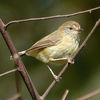Genus Acanthiza
Acanthiza apicalis - The Inland Thornbill , commonly called the Broad-tailed Thornbill, is a small, insect-eating bird of Australia. The Inland Thornbill is commonly confused with the coastal Brown Thornbill due to its similar colorations :
Yellow-rumped Thornbill - The Yellow-rumped Thornbill is a species of passerine bird from the genus Acanthiza. The genus was once placed in the family Pardalotidae but that family was split and it is now in the family Acanthizidae. There are four subspecies of Yellow-rumped Thornbill. It is a small, brownish bird with a distinctive yellow rump and thin dark bill. It inhabits savannah, scrub and forests across most of Australia and eats insects. The species engages in cooperative breeding.
Tasmanian Thornbill - Averaging 10 centimeters in length, the Tasmanian Thornbill is a small bird. Primarily light brown in coloration, the bird has a white undertail and a grey-streaked breast.
Western Thornbill - Its natural habitat is Mediterranean-type shrubby vegetation.
Samphire Thornbill - The Slender-billed Thornbill is a small bird native to Australia. It includes three separate sub-species:
Mountain Thornbill - Its natural habitat is tropical rainforest on the Atherton tableland in north-east Queensland.
Striated Thornbill - Its natural habitat is subtropical or tropical dry forests.
Papuan Thornbill - Its natural habitat is subtropical or tropical moist montanes.
Little Thornbill - The Yellow Thornbill, Acanthiza nana, is a passerine bird usually found in Australia. It is protected under the National Parks and Wildlife Act, 1974.
Brown Thornbill - The Brown Thornbill, Acanthiza pusilla, is a passerine bird usually found in eastern and south-eastern Australia, including Tasmania. It can grow up to 10 cm long, and feeds on insects.
Acanthiza reguloides - Since 1926 the Buff-rumped Thornbill and the Varied Thornbill have been combined as a single species.




